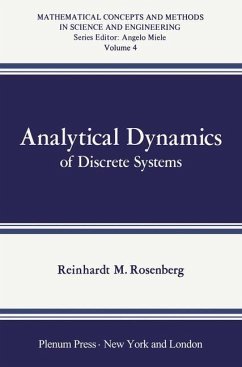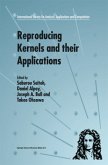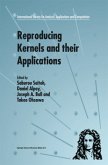R. Rosenberg
Analytical Dynamics of Discrete Systems
R. Rosenberg
Analytical Dynamics of Discrete Systems
- Broschiertes Buch
- Merkliste
- Auf die Merkliste
- Bewerten Bewerten
- Teilen
- Produkt teilen
- Produkterinnerung
- Produkterinnerung
This book is to serve as a text for engineering students at the senior or beginning graduate level in a second course in dynamics. It grew out of many years experience in teaching such a course to senior students in mechanical engineering at the University of California, Berkeley. While temperamentally disinclined to engage in textbook writing, I nevertheless wrote the present volume for the usual reason-I was unable to find a satisfactory English-language text with the content covered in my inter mediate course in dynamics. Originally, I had intended to fit this text very closely to the…mehr
Andere Kunden interessierten sich auch für
![Reproducing Kernels and their Applications Reproducing Kernels and their Applications]() Reproducing Kernels and their Applications81,99 €
Reproducing Kernels and their Applications81,99 €![Reproducing Kernels and their Applications Reproducing Kernels and their Applications]() S. Saitoh / Daniel Alpay / Joseph A. Ball / Takeo Ohsawa (Hgg.)Reproducing Kernels and their Applications83,99 €
S. Saitoh / Daniel Alpay / Joseph A. Ball / Takeo Ohsawa (Hgg.)Reproducing Kernels and their Applications83,99 €![Linear Equations in Banach Spaces Linear Equations in Banach Spaces]() KREINLinear Equations in Banach Spaces42,99 €
KREINLinear Equations in Banach Spaces42,99 €![Convolution Equations and Singular Integral Operators Convolution Equations and Singular Integral Operators]() Leonid Lerer / Vadim Olshevsky / Ilya M. Spitkovsky (Hrsg.) Oleksiy . Übersetzt von KarlovychConvolution Equations and Singular Integral Operators106,99 €
Leonid Lerer / Vadim Olshevsky / Ilya M. Spitkovsky (Hrsg.) Oleksiy . Übersetzt von KarlovychConvolution Equations and Singular Integral Operators106,99 €![Real and Functional Analysis Real and Functional Analysis]() Real and Functional Analysis42,99 €
Real and Functional Analysis42,99 €![Nonlinear Equations in Physics and Mathematics Nonlinear Equations in Physics and Mathematics]() P. Barut (Hrsg.)Nonlinear Equations in Physics and Mathematics125,99 €
P. Barut (Hrsg.)Nonlinear Equations in Physics and Mathematics125,99 €![Factorization, Singular Operators and Related Problems Factorization, Singular Operators and Related Problems]() Factorization, Singular Operators and Related Problems81,99 €
Factorization, Singular Operators and Related Problems81,99 €-
-
-
This book is to serve as a text for engineering students at the senior or beginning graduate level in a second course in dynamics. It grew out of many years experience in teaching such a course to senior students in mechanical engineering at the University of California, Berkeley. While temperamentally disinclined to engage in textbook writing, I nevertheless wrote the present volume for the usual reason-I was unable to find a satisfactory English-language text with the content covered in my inter mediate course in dynamics. Originally, I had intended to fit this text very closely to the content of my dynamics course for seniors. However, it soon became apparent that that course reflects too many of my personal idiosyncracies, and perhaps it also covers too little material to form a suitable basis for a general text. Moreover, as the manuscript grew, so did my interest in certain phases of the subject. As a result, this book contains more material than can be studied in one semester or quarter. My own course covers Chapters 1 to 5 (Chapters 1,2, and 3 lightly) and Chapters 8 to 20 (Chapter 17 lightly).
Hinweis: Dieser Artikel kann nur an eine deutsche Lieferadresse ausgeliefert werden.
Hinweis: Dieser Artikel kann nur an eine deutsche Lieferadresse ausgeliefert werden.
Produktdetails
- Produktdetails
- Mathematical Concepts and Methods in Science and Engineering
- Verlag: Springer / Springer US / Springer, Berlin
- Artikelnr. des Verlages: 978-1-4684-8320-8
- Softcover reprint of the original 1st ed. 1977
- Seitenzahl: 448
- Erscheinungstermin: 11. Dezember 2012
- Englisch
- Abmessung: 229mm x 152mm x 25mm
- Gewicht: 644g
- ISBN-13: 9781468483208
- ISBN-10: 146848320X
- Artikelnr.: 37479328
- Herstellerkennzeichnung Die Herstellerinformationen sind derzeit nicht verfügbar.
- Mathematical Concepts and Methods in Science and Engineering
- Verlag: Springer / Springer US / Springer, Berlin
- Artikelnr. des Verlages: 978-1-4684-8320-8
- Softcover reprint of the original 1st ed. 1977
- Seitenzahl: 448
- Erscheinungstermin: 11. Dezember 2012
- Englisch
- Abmessung: 229mm x 152mm x 25mm
- Gewicht: 644g
- ISBN-13: 9781468483208
- ISBN-10: 146848320X
- Artikelnr.: 37479328
- Herstellerkennzeichnung Die Herstellerinformationen sind derzeit nicht verfügbar.
1. Introduction.- 2. Dynamical Systems.- 2.1. Particles.- 2.2. Systems of Particles.- 2.3. Forces and Laws of Motion.- 2.4. Galilean Transformations.- 2.5. Arguments of the Forces.- 2.6. The Problems of Particle Mechanics.- 3. Representations of the Motion.- 3.1. The Configuration Space.- 3.2. The Event Space.- 3.3. The State Space.- 3.4. The State-Time Space.- 3.5. Notions on the Concept of Stability.- 3.6. Problems.- 4. Constraints.- 4.1. General Observations.- 4.2. Holonomic Constraints.- 4.3. Nonholonomic Constraints.- 4.4. The Pfaffian Forms.- 4.5. When is a System of Constraints Holonomic?.- 4.6. Accessibility (of the Configuration Space).- 4.7. Problems.- 5. The Strictly Newtonian Mechanics Problem.- 5.1. General Remarks.- 5.2. The Given Quantities and Relations.- 5.3. The First Problem.- 5.4. The Second Problem.- 5.5. Other Problems.- 5.6. Concluding Remarks.- 6. Some Rigid Body Kinematics.- 6.1. The Rigid Body.- 6.2. Finite Rotation.- 6.3. The Direction Cosines.- 6.4. Orthogonal Transformations.- 6.5. The Matrix Notation.- 6.6. Properties of the Rotation Matrix.- 6.7. The Composition of Rotations.- 6.8. Applications.- 6.9. Problems.- 7. Some Rigid Body Kinetics.- 7.1. Introductory Remarks.- 7.2. The Inertial Parameters in Rotated Axes.- 7.3. Angular Momentum and Principal Axes.- 7.4. The Ellipsoids of Cauchy and Poinsot.- 7.5. The General Motion of Rigid Bodies.- 7.6. Problems.- 8. The Nature of Lagrangean Mechanics.- 8.1. General Remarks.- 8.2. The Generalizations by Lagrange.- 9. Virtual Displacement and Virtual Work.- 9.1. General Observations.- 9.2. Classification of Displacements.- 9.3. D'Alembert's Principle.- 9.4. The Nature of the Forces of Constraint.- 9.5. The Virtual Velocity.- 9.6. The Variation.- 9.7. Possible Velocities and Accelerations.-9.8. The Fundamental Equation.- 9.9. The Nature of the Given Forces.- 9.10. Given Forces Which Are Functions of Constraint Forces.- 9.11. Problems.- 10. Hamilton's Principle.- 10.1. The Kinetic Energy.- 10.2. Kinetic Energy in Catastatic Systems.- 10.3. The Energy Relations in Catastatic Systems.- 10.4. The Central Principle.- 10.5. The Principle of Hamilton.- 10.6. Noncontemporaneous Variations.- 10.7. Lagrange's Principle of Least Action.- 10.8. Jacobi's Principle of Least Action.- 10.9. Problems.- 11. Generalized Coordinates.- 11.1. Introductory Remarks.- 11.2. The Theory of Generalized Coordinates.- 11.3. The Nature of Generalized Coordinates.- 11.4. The ? Operator for Generalized Coordinates.- 11.5. Exceptional Cases.- 11.6. Problems.- 12. The Fundamental Equation in Generalized Coordinates.- 12.1. The Kinetic Energy.- 12.2. Two Equalities.- 12.3. The Fundamental Equation.- 12.4. Generalized Potential Forces.- 12.5. Velocity-Dependent Potentials.- 12.6. Problems.- 13. Lagrange's Equations.- 13.1. The Dynamical Problem.- 13.2. The Multiplier Rule.- 13.3. Derivation from the Fundamental Equation.- 13.4. Derivation from the Central Principle.- 13.5. Derivation from Hamilton's Principle.- 13.6. Dynamic Coupling and Decoupling.- 13.7. Special Forms of Lagrange's Equations.- 13.8. The Principle of LeastAction Reconsidered.- 13.9. Problems.- 14. Embedding Constraints.- 14.1. Introductory Remarks.- 14.2. A Fallacy.- 14.3. Embedding of Nonholonomic Constraints..- 14.4. Problems.- 15. Formulating Problems by Lagrange's Equations.- 15.1. General Remarks.- 15.2. The Unconstrained Particle.- 15.3. The Holonomically Constrained Particle.- 15.4. The Nonholonomically Constrained Particle.- 15.5. Systems of Particles and Rigid Bodies.- 15.6. Problems.- 16. TheIntegration.- 16.1. The Meaning of an Integral.- 16.2. Jacobi's Integral.- 16.3. TheRouthianFunctionandtheMomentumIntegrals.- 16.4. Partial and Complete Separation of Variables.- 16.5. Solution in Quadratures.- 16.6. Qualitative Integration.- 16.7. Problems.- 17. Stability.- 17.1. Introductory Remarks.- 17.2. Definition of Stability.- 17.3. The Variational Equations.- 17.4. Some Remarks on Indirect Methods.- 17.5. Some Remarks on Liapunov's Direct Method.- 17.6. Problems.- 18. Applications.- 18.1. Introductory Remarks.- 18.2. The Single Particle.- 18.3. Systems of Particles.- 18.4. Nonholonomic Systems.- 18.5. Problems.- 19. About Celestial Problems.- 19.1. Historical Notes.- 19.2. The Central Force Problem.- 19.3. The Central Force Problem Continued-The Apsides.- 19.4. The Central Force Problem Continued-On Bertrand's Theorem.- 19.5. The n-Body Problem.- 19.6. The Two-Body Problem.- 19.7. Some Information about the Three-Body Problem.- 19.8. Problems.- 20. Topics in Gyrodynamics.- 20.1. Introduction.- 20.2. The Heavy Symmetrical Top.- 20.3. The Gyroscope.- 20.4. The Gyrocompass.- 20.5. Problems.- 21. Impulsive Motion.- 21.1. General Remarks.- 21.2. The Fundamental Equation.- 21.3. Impulsive Constraints.- 21.4. The Fundamental Equation with Impulsive Constraints.- 21.5. Impulsive Motion Theorems.- 21.6. Lagrange's Equations for Impulsive Motion.- 21.7. Problems.
1. Introduction.- 2. Dynamical Systems.- 2.1. Particles.- 2.2. Systems of Particles.- 2.3. Forces and Laws of Motion.- 2.4. Galilean Transformations.- 2.5. Arguments of the Forces.- 2.6. The Problems of Particle Mechanics.- 3. Representations of the Motion.- 3.1. The Configuration Space.- 3.2. The Event Space.- 3.3. The State Space.- 3.4. The State-Time Space.- 3.5. Notions on the Concept of Stability.- 3.6. Problems.- 4. Constraints.- 4.1. General Observations.- 4.2. Holonomic Constraints.- 4.3. Nonholonomic Constraints.- 4.4. The Pfaffian Forms.- 4.5. When is a System of Constraints Holonomic?.- 4.6. Accessibility (of the Configuration Space).- 4.7. Problems.- 5. The Strictly Newtonian Mechanics Problem.- 5.1. General Remarks.- 5.2. The Given Quantities and Relations.- 5.3. The First Problem.- 5.4. The Second Problem.- 5.5. Other Problems.- 5.6. Concluding Remarks.- 6. Some Rigid Body Kinematics.- 6.1. The Rigid Body.- 6.2. Finite Rotation.- 6.3. The Direction Cosines.- 6.4. Orthogonal Transformations.- 6.5. The Matrix Notation.- 6.6. Properties of the Rotation Matrix.- 6.7. The Composition of Rotations.- 6.8. Applications.- 6.9. Problems.- 7. Some Rigid Body Kinetics.- 7.1. Introductory Remarks.- 7.2. The Inertial Parameters in Rotated Axes.- 7.3. Angular Momentum and Principal Axes.- 7.4. The Ellipsoids of Cauchy and Poinsot.- 7.5. The General Motion of Rigid Bodies.- 7.6. Problems.- 8. The Nature of Lagrangean Mechanics.- 8.1. General Remarks.- 8.2. The Generalizations by Lagrange.- 9. Virtual Displacement and Virtual Work.- 9.1. General Observations.- 9.2. Classification of Displacements.- 9.3. D'Alembert's Principle.- 9.4. The Nature of the Forces of Constraint.- 9.5. The Virtual Velocity.- 9.6. The Variation.- 9.7. Possible Velocities and Accelerations.-9.8. The Fundamental Equation.- 9.9. The Nature of the Given Forces.- 9.10. Given Forces Which Are Functions of Constraint Forces.- 9.11. Problems.- 10. Hamilton's Principle.- 10.1. The Kinetic Energy.- 10.2. Kinetic Energy in Catastatic Systems.- 10.3. The Energy Relations in Catastatic Systems.- 10.4. The Central Principle.- 10.5. The Principle of Hamilton.- 10.6. Noncontemporaneous Variations.- 10.7. Lagrange's Principle of Least Action.- 10.8. Jacobi's Principle of Least Action.- 10.9. Problems.- 11. Generalized Coordinates.- 11.1. Introductory Remarks.- 11.2. The Theory of Generalized Coordinates.- 11.3. The Nature of Generalized Coordinates.- 11.4. The ? Operator for Generalized Coordinates.- 11.5. Exceptional Cases.- 11.6. Problems.- 12. The Fundamental Equation in Generalized Coordinates.- 12.1. The Kinetic Energy.- 12.2. Two Equalities.- 12.3. The Fundamental Equation.- 12.4. Generalized Potential Forces.- 12.5. Velocity-Dependent Potentials.- 12.6. Problems.- 13. Lagrange's Equations.- 13.1. The Dynamical Problem.- 13.2. The Multiplier Rule.- 13.3. Derivation from the Fundamental Equation.- 13.4. Derivation from the Central Principle.- 13.5. Derivation from Hamilton's Principle.- 13.6. Dynamic Coupling and Decoupling.- 13.7. Special Forms of Lagrange's Equations.- 13.8. The Principle of LeastAction Reconsidered.- 13.9. Problems.- 14. Embedding Constraints.- 14.1. Introductory Remarks.- 14.2. A Fallacy.- 14.3. Embedding of Nonholonomic Constraints..- 14.4. Problems.- 15. Formulating Problems by Lagrange's Equations.- 15.1. General Remarks.- 15.2. The Unconstrained Particle.- 15.3. The Holonomically Constrained Particle.- 15.4. The Nonholonomically Constrained Particle.- 15.5. Systems of Particles and Rigid Bodies.- 15.6. Problems.- 16. TheIntegration.- 16.1. The Meaning of an Integral.- 16.2. Jacobi's Integral.- 16.3. TheRouthianFunctionandtheMomentumIntegrals.- 16.4. Partial and Complete Separation of Variables.- 16.5. Solution in Quadratures.- 16.6. Qualitative Integration.- 16.7. Problems.- 17. Stability.- 17.1. Introductory Remarks.- 17.2. Definition of Stability.- 17.3. The Variational Equations.- 17.4. Some Remarks on Indirect Methods.- 17.5. Some Remarks on Liapunov's Direct Method.- 17.6. Problems.- 18. Applications.- 18.1. Introductory Remarks.- 18.2. The Single Particle.- 18.3. Systems of Particles.- 18.4. Nonholonomic Systems.- 18.5. Problems.- 19. About Celestial Problems.- 19.1. Historical Notes.- 19.2. The Central Force Problem.- 19.3. The Central Force Problem Continued-The Apsides.- 19.4. The Central Force Problem Continued-On Bertrand's Theorem.- 19.5. The n-Body Problem.- 19.6. The Two-Body Problem.- 19.7. Some Information about the Three-Body Problem.- 19.8. Problems.- 20. Topics in Gyrodynamics.- 20.1. Introduction.- 20.2. The Heavy Symmetrical Top.- 20.3. The Gyroscope.- 20.4. The Gyrocompass.- 20.5. Problems.- 21. Impulsive Motion.- 21.1. General Remarks.- 21.2. The Fundamental Equation.- 21.3. Impulsive Constraints.- 21.4. The Fundamental Equation with Impulsive Constraints.- 21.5. Impulsive Motion Theorems.- 21.6. Lagrange's Equations for Impulsive Motion.- 21.7. Problems.









